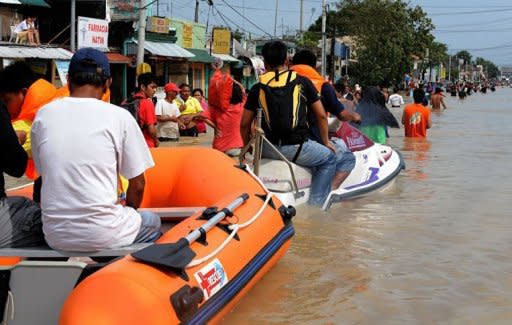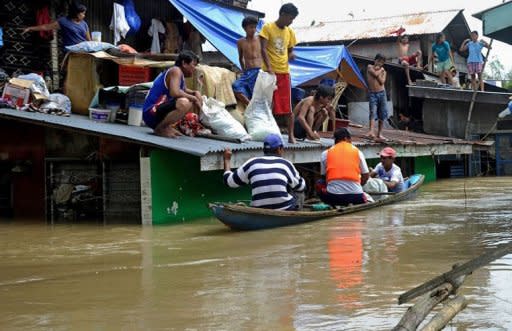Philippines struggles in typhoon aftermath
The Philippines deployed helicopters, inflatable boats and amphibious vehicles Sunday in a desperate bid to evacuate tens of thousands in the aftermath of successive monster storms. But rescuers and officials said it was close to impossible to pluck everyone to safety, with many refusing appeals to abandon their inundated homes despite warnings that flood waters may continue to rise. "We cannot evacuate them all. There are so many of them. That is impossible," said James de Jesus, mayor of Calumpit town where many residents were caught off-guard by the rising water. "We are calling for help from the armed forces to drop food and water to the thousands still on the roofs or second floor of their homes." Typhoon Nalgae blew out of the Philippines Saturday after a six-hour rampage across the country's main island Luzon, bringing fresh troubles for more than a million people still affected by Typhoon Nesat, which struck five days earlier. The two storms were among the most powerful to have struck the country this year, with their massive rain bands covering most of Luzon. Nalgae soaked the Cordillera mountain range, and water cascading from the slopes was expected to further swell tributaries and rivers in the flood-prone central Luzon plains, including Calumpit, before draining into Manila Bay. Office of Civil Defense administrator Benito Ramos said many residents refused calls to be rescued from their homes despite repeated warnings they were putting themselves in harm's way. "Water from the Cordilleras could reach the plains today and there is a possibility that there won't be any more rooftops left to see if that catches up with water from Nesat that's just now subsiding," he said. Frustrated emergency teams had fanned out across the area but could not force people off their roofs, he said. Waters however had continued to recede slowly by Sunday afternoon, though troops, police and volunteers were under orders to continue to work round the clock to reach isolated areas. Many Calumpit residents waded through waist-deep waters in search of food and drinking water but found that even the town hall was inundated. They clung to ropes tied on lamp posts so as not to be swept away by the strong current, while others carried improvised flotation devices such as empty water bottles. Those with access to small canoes ferried supplies to stranded relatives, or moved out pets and livestock. Volunteers on rubber boats went from one flooded home to another to hand over relief items, including dry clothes and instant noodles. A white coffin was also seen rigged on a canoe, but the grieving relatives had nowhere to take the dead with the cemetery also waterlogged. "This is the first time in my entire life that I have seen our town submerged in such a flood," retired government employee Josefina Barleta, 69, told AFP. "The water began rising last week, and we were not able to save anything except the clothes on our backs and a cooking stove." But Barleta said she, her four adult children and several grandchildren preferred to stay dry on their roof than be taken to a crowded evacuation centre that is also running in dirty water. Ropalyn Sebastian, 26, a toll booth clerk, sloshed through the flood Sunday in a bid to reach her family in the next town. "I have been trapped here for the last four days," said Sebastian, who was visiting a friend in Calumpit when Nesat struck last week. She said her family told her they were stranded on the second floor of their home before electricity and phone lines went dead. "Help is slow to arrive, and even the municipal hall is flooded," she said. Social work secretary Corazon Soliman said tonnes of relief packs were being trucked to the affected areas with the help of the UN's food agency, but said other areas remained cut off. "The main challenge is reaching far-flung villages. We are working with the armed forces and police to reach whatever is possible by food or by choppers," she said. The National Disaster Risk Reduction Management Council in Manila recorded only one death from Nalgae, but said Nesat left at least 52 people dead after it unleashed strong winds and devastating floods. More than 2.4 million people were affected by Nesat in total, and nearly half a million of them are still staying in evacuation centres.





